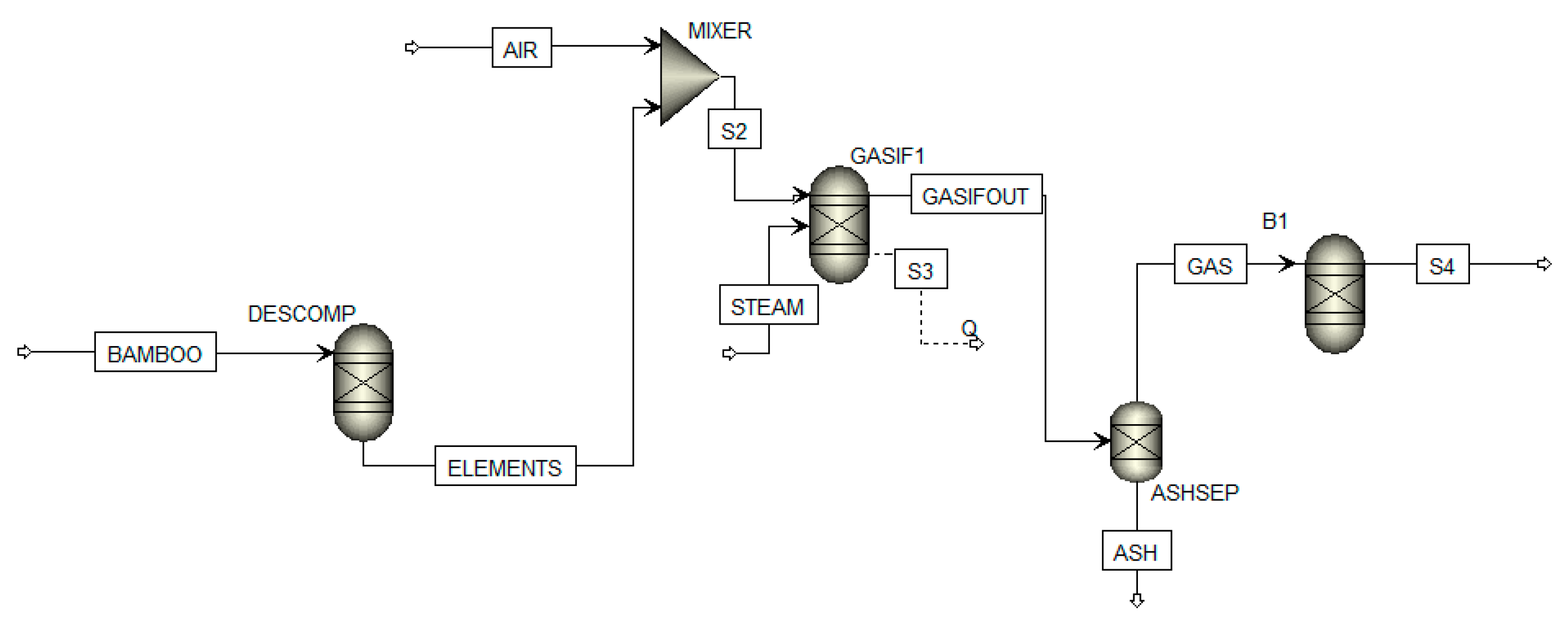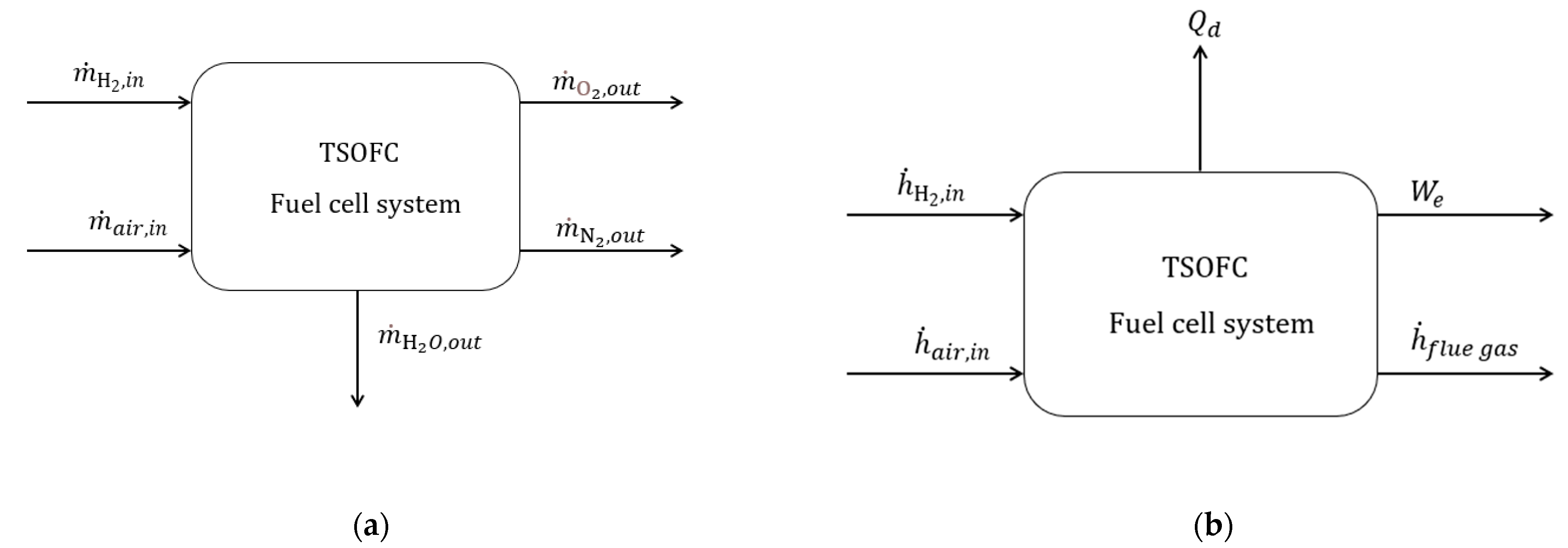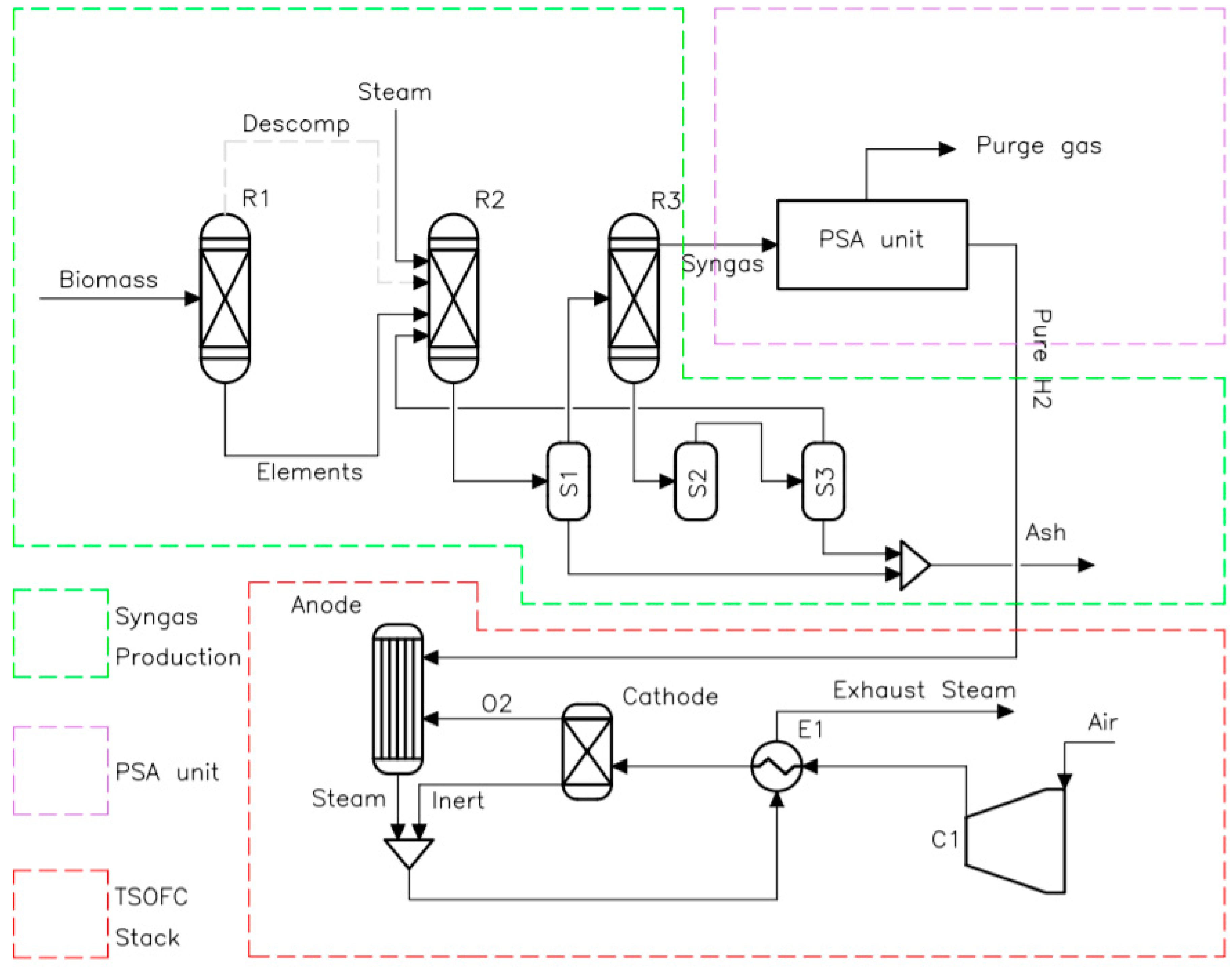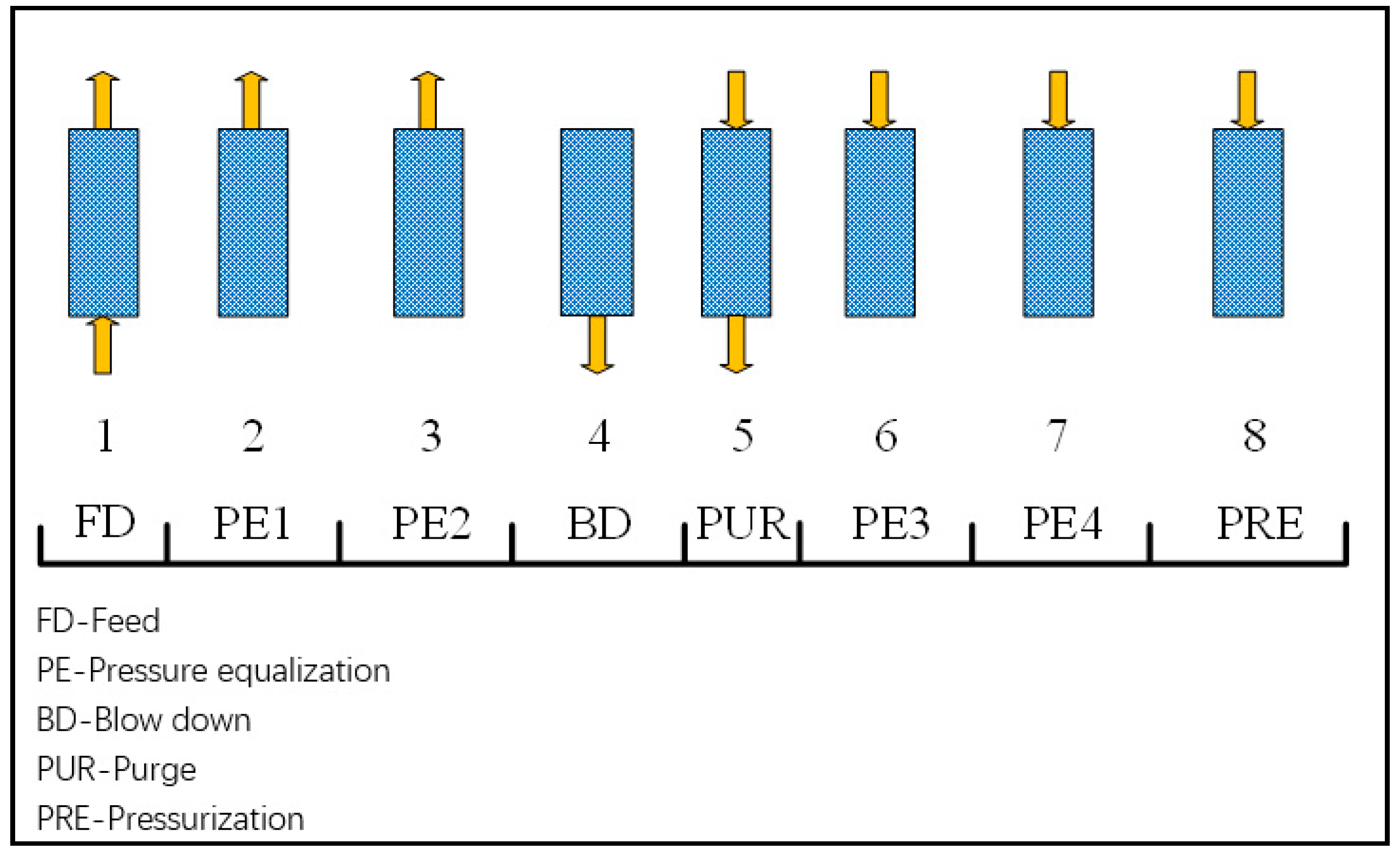Techno-Environmental Analysis of the Use of Green Hydrogen for Cogeneration from the Gasification of Wood and Fuel Cell
Abstract
1. Introduction
2. Methodology
2.1. Process Description
2.1.1. Syngas Production from Wood Gasification
- The system is isothermal and operates under steady-state conditions without transients.
- Pressure drops are overlooked. The formation of tars is neglected.
- The composition of the char is 100% carbon.
- The process is carried out under atmospheric pressure.
- Heat losses from the gasifier are ignored.
2.1.2. H2 Purification Using a PSA Unit
2.1.3. Power and Heat Generation through a TSOFC
3. Results and Discussion
4. Conclusions
Author Contributions
Funding
Institutional Review Board Statement
Informed Consent Statement
Data Availability Statement
Acknowledgments
Conflicts of Interest
Nomenclature
| AC | Activated carbon |
| BECC | Bioenergy with carbon capture and sequestration |
| CBC | Coastal blue carbon |
| CCS | carbon capture and storage |
| CCUS | carbon capture use and storage |
| DAC | Direct air capture |
| ER | equivalence ratio |
| GHG | greenhouse gas |
| HHV | higher heating value |
| IEA | International Energy Agency |
| LHV | Lower heating value |
| LPG | Liquid petroleum gas |
| MA-GSR | membrane-assisted gas switching reforming |
| NET | negative emissions technologies |
| NGCC | Combined cycle power plant |
| NG | Natural gas |
| PEM | proton exchange membrane |
| SMR | steam methane reforming |
| SOFT | solid oxide fuel cells |
| PSA | pressure swing adsorption |
| PSOFC | planar SOFC |
| S/B | steam to biomass |
| TCRS | Terrestrial Carbon Removal and Sequestration |
| TSA | temperature swing adsorption |
| TSOFC | tubular solid oxide fuel cell |
| VPSA | vacuum pressure swing adsorption |
Appendix A

| Stream Name | Units | ASH | BIOMASS | ELEMENTS | GAS | GASIFOUT | S2 | S4 | STEAM |
|---|---|---|---|---|---|---|---|---|---|
| Temperature | K | 1100.1 | 298.2 | 298.2 | 1100.1 | 1100.2 | 298.2 | 1123.2 | 423.2 |
| Pressure | atm | 1.04 | 1.00 | 1.04 | 1.04 | 1.04 | 1.04 | 1.04 | 1.04 |
| Mass Flows | kg/hr | 2.8 | 132.0 | 132.0 | 189.5 | 192.3 | 132.0 | 189.5 | 60.3 |
| Mole Fractions | |||||||||
| H2 | 0.6379 | 0.4899 | 0.4899 | 0.6379 | 0.5240 | 0.0000 | |||
| O2 | 0.2110 | 0.0000 | 0.0000 | 0.2110 | 0.0000 | 0.0000 | |||
| N2 | 0.0006 | 0.0003 | 0.0003 | 0.0006 | 0.0003 | 0.0000 | |||
| H2O | 0.1489 | 0.1213 | 0.1213 | 0.1489 | 0.1154 | 1.0000 | |||
| CO | 0.0000 | 0.2405 | 0.2405 | 0.0000 | 0.2984 | 0.0000 | |||
| CO2 | 0.0000 | 0.1071 | 0.1071 | 0.0000 | 0.0603 | 0.0000 | |||
| CH4 | 0.0000 | 0.0399 | 0.0399 | 0.0000 | 0.0008 | 0.0000 | |||
| H2S | 0.0000 | 0.0009 | 0.0009 | 0.0000 | 0.0008 | 0.0000 | |||
| H3N | 0.0000 | 0.0000 | 0.0000 | 0.0000 | 0.0000 | 0.0000 | |||
| S | 0.0016 | 0.0000 | 0.0000 | 0.0016 | 0.0000 | 0.0000 | |||
| C | 0.0000 | 0.0000 | 0.0000 | 0.0000 | 0.0000 | 0.0000 | |||
| CL2 | 0.0000 | 0.0000 | 0.0000 | 0.0000 | 0.0000 | 0.0000 | |||
| HCL | 0.0000 | 0.0000 | 0.0000 | 0.0000 | 0.0000 | 0.0000 |
| Stream Name | Units | ASH | BAMBOO | ELEMENTS | GAS | GASIFOUT | S2 | S4 | STEAM |
|---|---|---|---|---|---|---|---|---|---|
| Temperature | K | 1100.1 | 298.2 | 298.2 | 1100.1 | 1100.2 | 298.2 | 1123.2 | 423.2 |
| Pressure | atm | 1.04 | 1.00 | 1.04 | 1.04 | 1.04 | 1.04 | 1.04 | 1.04 |
| Mass Flows | kg/hr | 0.51 | 132.00 | 132.00 | 211.82 | 212.34 | 132.00 | 211.82 | 80.34 |
| Mole Fractions | |||||||||
| H2 | 0.6379 | 0.4909 | 0.4909 | 0.6379 | 0.5084 | 0.0000 | |||
| O2 | 0.2110 | 0.0000 | 0.0000 | 0.2110 | 0.0000 | 0.0000 | |||
| N2 | 0.0006 | 0.0003 | 0.0003 | 0.0006 | 0.0003 | 0.0000 | |||
| H2O | 0.1489 | 0.1481 | 0.1481 | 0.1489 | 0.1503 | 1.0000 | |||
| CO | 0.0000 | 0.2143 | 0.2143 | 0.0000 | 0.2673 | 0.0000 | |||
| CO2 | 0.0000 | 0.1163 | 0.1163 | 0.0000 | 0.0725 | 0.0000 | |||
| CH4 | 0.0000 | 0.0293 | 0.0293 | 0.0000 | 0.0005 | 0.0000 | |||
| H2S | 0.0000 | 0.0008 | 0.0008 | 0.0000 | 0.0007 | 0.0000 | |||
| H3N | 0.0000 | 0.0000 | 0.0000 | 0.0000 | 0.0000 | 0.0000 | |||
| S | 0.0016 | 0.0000 | 0.0000 | 0.0016 | 0.0000 | 0.0000 | |||
| C | 0.0000 | 0.0000 | 0.0000 | 0.0000 | 0.0000 | 0.0000 | |||
| CL2 | 0.0000 | 0.0000 | 0.0000 | 0.0000 | 0.0000 | 0.0000 | |||
| HCL | 0.0000 | 0.0000 | 0.0000 | 0.0000 | 0.0000 | 0.0000 |

| Item | Unit | Inlet |
|---|---|---|
| Air mass flow | kg/s | 0.1133 |
| Air pressure | bar | 2.3 |
| Air temperature | °C | 320 |
| Air enthalpy flow | J/s | 25,073.6 |
| H2 mass flow | kg/s | 0.0029 |
| H2 pressure | bar | 2 |
| H2 temperature | °C | 105 |
| H2 enthalpy flow | J/s | 138.215 |
| Gas composition | ||
| O2 | Mole fraction | 0.019 |
| N2 | Mole fraction | 0.658 |
| H2O | Mole fraction | 0.322 |
| Flue gas flow rate | kg/s | 0.116 |
| Flue gas pressure | Bar | 2 |
| Flue gas temperature | °C | 355.54 |
| Steam produced | kg/h | 45 |
| Steam pressure | bar | 3 |
| Temperature | °C | 300 |
| Power pump | kW | 0.0084 |
References
- National Academies of Sciences, E. Negative Emissions Technologies and Reliable Sequestration: A Research Agenda; National Academies Press: Washington, DC, USA, 2018. [Google Scholar]
- Meyer, L.; Brinkman, S.; van Kesteren, L.; Leprince-Ringuet, N.; van Boxmeer, F. Contribution of Working Groups I, II and III to the Fifth Assessment Report of the Intergovernmental Panel on Climate Change; Synthesis Report: Geneva, Switzerland, 2014; p. 169. [Google Scholar]
- IEA. Energy Technology Perspectives 2020; IEA Webstore: London, UK, 2020. [Google Scholar]
- Stafford, W.; Lotter, A.; Brent, A.; von Maltitz, G. Biofuels Technology: A Look Forward; United Nations World Institute for Development Economics Research: Helsinki, Finland, 2017. [Google Scholar]
- Rios, M.; Kaltschmitt, M. Bioenergy potential in Mexico—Status and perspectives on a high spatial distribution. Biomass Convers. Biorefinery 2013, 3, 239–254. [Google Scholar] [CrossRef]
- Aldana, H.; Lozano, F.J.; Acevedo, J. Evaluating the potential for producing energy from agricultural residues in México using MILP optimization. Biomass Bioenergy 2014, 67, 372–389. [Google Scholar] [CrossRef]
- IRENA. Hydrogen from Renewable Power: Technology Outlook for the Energy Transition; International Renewable Energy Agency: Abu Dhabi, United Arab Emirates, 2018. [Google Scholar]
- IRENA. Hydrogen: A Renewable Energy Perspective; International Renewable Energy Agency: Abu Dhabi, United Arab Emirates, 2019. [Google Scholar]
- IRENA. Global Energy Transformation: A Roadmap to 2050, 2019th; International Renewable Energy Agency: Abu Dhabi, United Arab Emirates, 2019. [Google Scholar]
- CCC. Hydrogen in a Low-Carbon Economy; Committee on Climate Change: London, UK, 2018. [Google Scholar]
- Díaz-Herrera, P.R.; Ascanio, G.; Romero-Martínez, A.; Alcaraz-Calderón, A.M.; González-Díaz, A. Theoretical comparison between post-combustion carbon capture technology and the use of blue and green H2 in existing natural gas combined cycles as CO2 mitigation strategies: A study under the context of mexican clean energy regulation. Int. J. Hydrogen Energy 2021, 46, 2729–2754. [Google Scholar] [CrossRef]
- IEAGHG. Techno-Economic Evaluation of SMR Based Standalone (Merchant) Hydrogen Plant with CCS; IEAGHG Document Manager: Cheltenham, UK, 2017. [Google Scholar]
- GE. General Electric (GE): Power to Gas: Hydrogen For Power Generation; GE Document Number: GEA33861; GE: Boston, MA, USA, 2019. [Google Scholar]
- Programa Especial Para el Aprovechamiento de Energías Renovables. 2014. Available online: https://www.dof.gob.mx/nota_detalle.php?codigo=5342501&fecha=28/04/2014 (accessed on 1 March 2021).
- Edenhofer, O. Bioenergy. In IPCC Special Report on Renewables Energy Sources and Climate Change Mitigation; Cambridge University Press: Cambridge, UK, 2011. [Google Scholar]
- SEMARNAT-INECC. Mexico’s Climate Change Mid-Century Strategy; Ministry of Environment and Natural Resources (SEMARNAT) and National Institute of Ecology and Climate Change (INECC): Veracruz, Mexico, 2016. [Google Scholar]
- Santin, M.; Traverso, A.; Magistri, L.; Massardo, A. Thermoeconomic analysis of SOFC-GT hybrid systems fed by liquid fuels. Energy 2010, 35, 1077–1083. [Google Scholar] [CrossRef]
- Larminie, J.; Dicks, A. Fuel Cell Systems Explained, 2nd ed.; John Wiley & Sons Ltd.: Hoboken, NJ, USA, 2003. [Google Scholar]
- Jiang, L.; Gonzalez-Diaz, A.; Ling-Chin, J.; Roskilly, A.; Smallbone, A. Post-combustion CO2 capture from a natural gas combined cycle power plant using activated carbon adsorption. Appl. Energy 2019, 245, 1–15. [Google Scholar] [CrossRef]
- Jiang, L.; Roskilly, A.; Wang, R. Performance exploration of temperature swing adsorption technology for carbon dioxide capture. Energy Convers. Manag. 2018, 165, 396–404. [Google Scholar] [CrossRef]
- Ye, F.; Ma, S.; Tong, L.; Xiao, J.; Bénard, P.; Chahine, R. Artificial neural network based optimization for hydrogen purification performance of pressure swing adsorption. Int. J. Hydrogen Energy 2019, 44, 5334–5344. [Google Scholar] [CrossRef]
- Liu, B.; Yu, X.; Shi, W.; Shen, Y.; Zhang, D.; Tang, Z. Two-stage VSA/PSA for capturing carbon dioxide (CO2) and producing hydrogen (H2) from steam-methane reforming gas. Int. J. Hydrogen Energy 2020, 45, 24870–24882. [Google Scholar] [CrossRef]
- Wassie, S.A.; Cloete, S.; Spallina, V.; Gallucci, F.; Amini, S.; Annaland, M.V.S. Techno-economic assessment of membrane-assisted gas switching reforming for pure H2 production with CO2 capture. Int. J. Greenh. Gas Control. 2018, 72, 163–174. [Google Scholar] [CrossRef]
- Murugan, S.; Horák, B. A review of micro combined heat and power systems for residential applications. Renew. Sustain. Energy Rev. 2016, 64, 144–162. [Google Scholar] [CrossRef]
- Zheng, X.; Chen, C.; Ying, Z.; Wang, B. Experimental study on gasification performance of bamboo and PE from municipal solid waste in a bench-scale fixed bed reactor. Energy Convers. Manag. 2016, 117, 393–399. [Google Scholar] [CrossRef]
- Chiang, K.-Y.; Chen, Y.-S.; Tsai, W.-S.; Lu, C.-H.; Chien, K.-L. Effect of calcium based catalyst on production of synthesis gas in gasification of waste bamboo chopsticks. Int. J. Hydrogen Energy 2012, 37, 13737–13745. [Google Scholar] [CrossRef]
- Usack, J.; Van Doren, L.G.; Posmanik, R.; Tester, J.; Angenent, L. Harnessing anaerobic digestion for combined cooling, heat, and power on dairy farms: An environmental life cycle and techno-economic assessment of added cooling pathways. J. Dairy Sci. 2019, 102, 3630–3645. [Google Scholar] [CrossRef] [PubMed]
- Islam, M.W. Effect of different gasifying agents (steam, H2O2, oxygen, CO2, and air) on gasification parameters. Int. J. Hydrogen Energy 2020, 45, 31760–31774. [Google Scholar] [CrossRef]
- Brea, P.; Delgado, J.; Águeda, V.I.; Uguina, M.A. Comparison between MOF UTSA-16 and BPL activated carbon in hydrogen purification by PSA. Chem. Eng. J. 2019, 355, 279–289. [Google Scholar] [CrossRef]
- Tanim, T.; Bayless, D.J.; Trembly, J.P. Modeling of a 5 kWe tubular solid oxide fuel cell based system operating on desulfurized JP-8 fuel for auxiliary and mobile power applications. J. Power Sources 2013, 221, 387–396. [Google Scholar] [CrossRef]
- de Souza-Santos, M.L. Solid Fuels Combustion and Gasification; Taylor & Francis Group: Abingdon, UK, 2010. [Google Scholar]
- Song, T.W.; Sohn, J.L.; Kim, J.H.; Kim, T.S.; Ro, S.T.; Suzuki, K. Performance analysis of a tubular solid oxide fuel cell/micro gas turbine hybrid power system based on a quasi-two dimensional model. J. Power Sources 2005, 142, 30–42. [Google Scholar] [CrossRef]
- George, R.A. Status of tubular SOFC field unit demonstrations. J. Power Sources 2000, 86, 134–139. [Google Scholar] [CrossRef]
- Costamagna, P.; Magistri, L.; Massardo, A. Design and part-load performance of a hybrid system based on a solid oxide fuel cell reactor and a micro gas turbine. J. Power Sources 2001, 96, 352–368. [Google Scholar] [CrossRef]
- Doherty, W.; Reynolds, A.; Kennedy, D. Computer simulation of a biomass gasification-solid oxide fuel cell power system using Aspen Plus. Energy 2010, 35, 4545–4555. [Google Scholar] [CrossRef]
- Nikoo, M.B.; Mahinpey, N. Simulation of biomass gasification in fluidized bed reactor using ASPEN PLUS. Biomass Bioenergy 2008, 32, 1245–1254. [Google Scholar] [CrossRef]
- Kobayashi, Y.; Tomida, K.; Nishiura, M.; Hiwatashi, K.; Kishizawa, H. Development of Next-Generation Large-Scale SOFC toward Realization of a Hydrogen Society. Mitsubishi Heavy Ind. Tech. Rev. 2015, 52, 111. [Google Scholar]
- Gas Turbine World 2018, GTW Handbook; Pequot Publishing Inc.: Fairfield, CT, USA, 2018; Volume 30.


| Ultimate Analysis (wt.%, Dry) | Wood Chip (Islam, 2020) [28] |
|---|---|
| Ash | 0.450 |
| Carbon | 52.463 |
| Hydrogen | 7.466 |
| Nitrogen | 0.100 |
| Sulfur | 0.299 |
| Oxygen | 39.223 |
| Proximate analysis (wt.%, dry) | |
| Fixed carbon | 17.15 |
| Volatile matter | 82.4 |
| Ash | 0.45 |
| Moisture | 13.48 |
| Low heating value (LHV) (MJ/kg) | 19.54 |
| ER | 0.25 |
| Temperature (°C) | 827 |
| Pyrolysis | endothermic stage | Biomass ↔ H2 + CO + CO2 + CH4 + H2O(g) + Tar + Char |
| Oxidation | exothermic stage | C + O2 → CO2 Char combustion C + ½O2 → CO Partial oxidation H2 + ½O2 → H2O Hydrogen combustion |
| Reduction | endothermic stage | C + CO2 ↔ 2CO Boudouard reaction C + H2O ↔ CO + H2 Reforming of the Char CO + H2O ↔ CO2 + H2 Water shift reaction C + 2H2 ↔ CH4 Methanation |
| Wood Chip | Reference (Islam, 2020) [28] Experimental | Reference (Islam, 2020) [28] Aspen Plus Simulation (RSS) c | This Work a Aspen Plus Simulation (RSS) c |
|---|---|---|---|
| H2 (% mol) | 8 | 13 (0.39) | 26.64 (5.43) |
| N2 (% mol) | N.A. b | N.A. b | 36.10 |
| H2O (% mol) | N.A. b | N.A. b | 5.90 |
| CO (% mol) | 19.5 | 22.5 (0.02) | 21.52 (0.01) |
| CO2 (% mol) | 6.5 | 11 (0.48) | 8.57 (0.10) |
| CH4 (% mol) | 4 | 11 (3.06) | 1.18 (0.49) |
| Low heating value (LHV) (MJ/Nm3) | 4.93 | 8.48 (0.52) | 6.24 (0.07) |
| Carbon conversion efficiency | N.A. b | N.A. b | 0.935 |
| S/B Ratio | 0.3 | 0.4 | 0.6 |
|---|---|---|---|
| H2 mol% | 48.99 | 49.09 | 47.85 |
| N2 mol% | 0.03 | 0.03 | 0.02 |
| H2O mol% | 12.13 | 14.81 | 21.73 |
| CO mol% | 24.05 | 21.43 | 15.94 |
| CO2 mol% | 10.71 | 11.63 | 13.01 |
| CH4 mol% | 3.99 | 2.93 | 1.38 |
| LHV (MJ/Nm3) | 10.12 | 9.39 | 7.96 |
| Carbon conversion efficiency | 0.961 | 1.0 | 1.0 |
| PSA Results | Units | S/B | |
|---|---|---|---|
| 0.4 | 0.3 | ||
| Composition in the Purge Gas | |||
| H2 | mass fraction | 0.0709 | 0.0744 |
| O2 | mass fraction | 9.747 × 10−19 | 5.499 × 10−19 |
| N2 | mass fraction | 0.000537 | 0.000601 |
| H2O | mass fraction | 0.1874 | 0.1464 |
| CO | mass fraction | 0.5181 | 0.5888 |
| CO2 | mass fraction | 0.2208 | 0.1869 |
| CH4 | mass fraction | 0.00055 | 0.00089 |
| H2S | mass fraction | 0.0017 | 0.0019 |
| H3N | mass fraction | 2.108 × 10−6 | 2.354 × 10−6 |
| S | mass fraction | 8.459 × 10−12 | 9.176 × 10−12 |
| Flow rate of H2 | kg/h | 10.57 | 10.54 |
| Work capacity | kJ/molH2 | 4.76 | 4.80 |
| H2 recovery | % | 75.1 | 74.3 |
| Work capacity | kW | 6.98 | 7.02 |
| TSOFC Results | Unit | This Work | Mitsubishi Hitachi Power Systems MEGAMIE [37] | Siemens–Westinghouse [32,33] |
|---|---|---|---|---|
| Cell operating temperature | °C | 850 | 850 | 850 |
| Cell voltage | V | 0.831 | 0.11 | 0.61 |
| AC Power output | kW | 217.1 | 210 | 220 |
| Net electrical efficiency | % | 58.2 | 53.0 | 57.0 |
| Power consumption of air compressor | kW | 12.12 | - | - |
| Discharge air pressure | bar | 2.3 | - | - |
| Flue gas mass flow | kg/s | 0.1165 | N.A. | N.A. |
| H2 fuel consumption | kg/s | 0.0029 | N.A. | N.A. |
| Supplementary fuel | kg/h | 0.80 | ||
| Steam generated | kg/h | 60 |
| Concept | Unit | Amount |
|---|---|---|
| Biomass mass flow | kg/h | 132 |
| LHV of biomass | kJ/kg | 19,540 |
| LHV natural gas | kJ/kg | 50,047 |
| Supplementary gas | kg/h | 0.8 |
| H2 produced | kg/h | 10.57 |
| AC gross power output | kW | 217.1 |
| Total work duty required for H2 separation | kW | 6.98 |
| Total word required to pump the water for steam in the fuel cell | kW | 0.084 |
| Power consumption of air compressor | kW | 12.12 |
| Net power | kW | 197.92 |
| Net efficiency | % | 27.20 |
| CO2 generated in the gasifier | kg/h | 35.41 |
Publisher’s Note: MDPI stays neutral with regard to jurisdictional claims in published maps and institutional affiliations. |
© 2021 by the authors. Licensee MDPI, Basel, Switzerland. This article is an open access article distributed under the terms and conditions of the Creative Commons Attribution (CC BY) license (http://creativecommons.org/licenses/by/4.0/).
Share and Cite
Gonzalez-Diaz, A.; Sánchez Ladrón de Guevara, J.C.; Jiang, L.; Gonzalez-Diaz, M.O.; Díaz-Herrera, P.; Font-Palma, C. Techno-Environmental Analysis of the Use of Green Hydrogen for Cogeneration from the Gasification of Wood and Fuel Cell. Sustainability 2021, 13, 3232. https://doi.org/10.3390/su13063232
Gonzalez-Diaz A, Sánchez Ladrón de Guevara JC, Jiang L, Gonzalez-Diaz MO, Díaz-Herrera P, Font-Palma C. Techno-Environmental Analysis of the Use of Green Hydrogen for Cogeneration from the Gasification of Wood and Fuel Cell. Sustainability. 2021; 13(6):3232. https://doi.org/10.3390/su13063232
Chicago/Turabian StyleGonzalez-Diaz, Abigail, Juan Carlos Sánchez Ladrón de Guevara, Long Jiang, Maria Ortencia Gonzalez-Diaz, Pablo Díaz-Herrera, and Carolina Font-Palma. 2021. "Techno-Environmental Analysis of the Use of Green Hydrogen for Cogeneration from the Gasification of Wood and Fuel Cell" Sustainability 13, no. 6: 3232. https://doi.org/10.3390/su13063232
APA StyleGonzalez-Diaz, A., Sánchez Ladrón de Guevara, J. C., Jiang, L., Gonzalez-Diaz, M. O., Díaz-Herrera, P., & Font-Palma, C. (2021). Techno-Environmental Analysis of the Use of Green Hydrogen for Cogeneration from the Gasification of Wood and Fuel Cell. Sustainability, 13(6), 3232. https://doi.org/10.3390/su13063232









